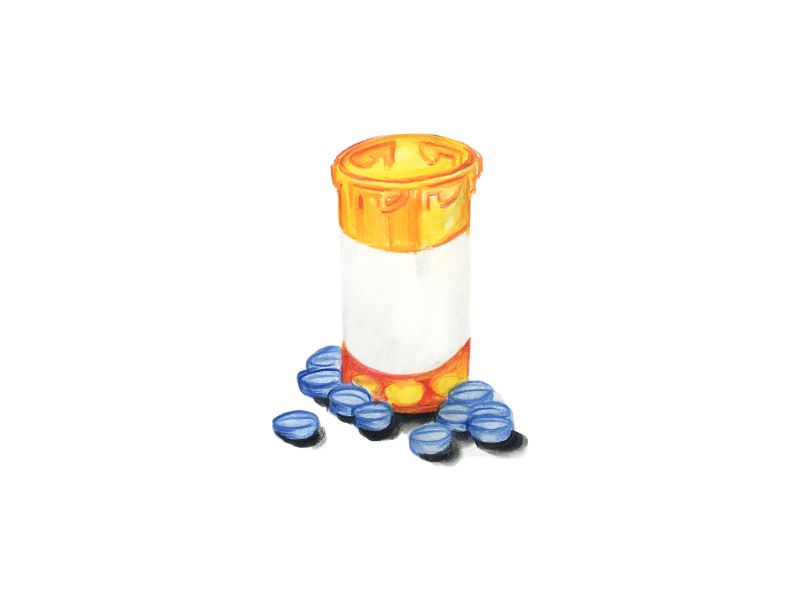The last thing Maddy remembers is being inside the small bathroom of a motorhome parked on an East Vancouver street. When she regained consciousness, she was lying on a bed. A man was on top of her, and he wasn’t wearing a condom.
He was a client who’d been pressuring her to have unprotected sex. She’d said no every time: using a condom is a rule Maddy never lets men break because of the risk of getting a sexually transmitted infection.
“When I came to, I was like, ‘Dude, what the fuck?’” Maddy said. “I don’t remember exactly what he said but he just made up some excuse about why he thought it was OK.”
Maddy was raped after buying “benzo-dope,” a mix of fentanyl and benzodiazepines that is increasingly common in Vancouver’s illicit drug supply.
It wasn’t the first time a client had taken advantage of her drug use to have sex without a condom: shortly before the incident in the motorhome, another man had pressured her to have unprotected sex after she had used benzos. That man had previously respected her boundaries and agreed to use a condom during a previous encounter when she was not intoxicated. (Maddy says in both cases, she was using drugs she had bought herself, not drugs her clients had given her.)
“It was only when I was in more of a semi-blackout state, not like a full-on blackout, that I said, ‘Fuck it,’ and just went,” Maddy said. “That was more of a grey area, but it was more coercive because he knew I wasn’t OK with it.”
Maddy is dealing with an addiction to both fentanyl and benzodiazepines, and she believes safe supply (being prescribed a pharmaceutical-grade substance as an alternative to the unpredictable illicit supply) helped her avoid the worst pitfalls of benzo-dope. The sexual assault happened just four months after she was cut off from a prescribed benzodiazepine.
Benzodiazepines like lorazepam and diazepam are commonly prescribed to treat anxiety and act as depressants. But in the illicit supply, benzos are often unregulated concoctions advertised as “research chemicals” that are “not for human consumption.” Unregulated benzos are often much stronger than their regulated counterparts.
People who take both unregulated and prescribed benzodiazepines are at high risk of becoming dependent on them. Long-term use can cause sleep problems and a decline in cognitive function.
Benzodiazepines can affect people’s ability to breathe properly. When they’re mixed with opioids, benzos complicate overdoses and increase the chance that the overdose will be fatal.
Some opioid users don’t even know they’re also addicted to benzodiazepines, leading to dangerous situations when people try to detox, said Dr. Paxton Bach, the co-medical director at the BC Centre for Substance Use.
Benzodiazepine withdrawal feels much worse and takes longer than getting off opioids, and some patients also have seizures during withdrawal.
“It’s a nightmare scenario,” said Bach of the increase of benzodiazepines in B.C.’s illicit drug supply.
While North America’s current drug poisoning crisis is mostly caused by the powerful synthetic opioid fentanyl, overdose prevention sites in Vancouver started noticing drugs tainted with benzos were causing more complicated overdoses in early 2019.
Since then, benzodiazepines have become more common. In September, the BC Centre for Substance Use reported benzos had been found in 26 per cent of the illicit drugs tested at drug checking sites. That’s the highest rate ever found, and it’s likely an undercount because a common unregulated benzodiazepine called etizolam is often missed by drug-checking technologies.
For drug users, the effects of taking benzo-dope are unpredictable.
Sometimes, Maddy said, the illicit benzos she was taking would cause deep blackouts, where she was completely unconscious. Other times, “you’re in a state where you’re lucid, but you’re making decisions you wouldn’t otherwise make.”
After becoming addicted to both fentanyl and benzodiazepines because of the contaminated illicit opioid supply, Maddy said she was on a form of suboxone, a medication to treat opioid addiction. She was also prescribed a regulated benzodiazepine called clonazepam by a nurse practitioner. The clonazepam was prescribed as a harm reduction method to use after relapses or to prevent them, Maddy said.
It was only after she had been cut off the clonazepam prescription that she started to specifically seek out benzo-dope. Her use also became more frequent, and the drugs were unpredictable.
“I would get something different every time,” she said.
Jasmine, a friend of Maddy’s who acts as her safety partner for sex work and for drug use, said unregulated benzodiazepines are making sex work extremely dangerous.
“What do you think is going to happen when you pass out around a client? There’s a very good chance that they’re going to hurt you,” Jasmine said.
“It was maybe a year ago that I started seeing stuff on the bad date reports about girls getting drugged with benzo-dope, and then waking up and being raped. This is so common, it’s happening all the time, and it’s just disgusting.”
The Tyee is referring to Maddy and Jasmine by pseudonyms for safety reasons.
Jasmine said she first heard of benzo-dope a year ago, when a friend who was experiencing homelessness would routinely wake up missing all his belongings, including most of his clothes.
“It just kept happening to him,” Jasmine said. “He just kept waking up in an alley, not knowing what the fuck happened to him. That was the first I heard about benzos.”
Since then, it’s become “an epidemic,” she said.
Jasmine still remembers how upset Maddy was the day she found out she’d been cut off from her benzodiazepine prescription.
“She was just crying, and I was hugging her and she was saying, ‘They’re cutting me off, I’m going to fucking die, I told them I’m going to end up dead,’” Jasmine said.
“We need regulated sources where you can take the amount that’s going to make you feel the way you want to feel, but not too intoxicated that you can’t function, and you can’t do your job and be safe.”
Bach said in the past, doctors have avoided prescribing benzodiazepines and opioids together, or been extremely cautious when doing it.
But Bach said health-care practitioners are increasingly seeing patients with addictions to both opioids and benzodiazepines and are having to rethink how to prescribe benzodiazepines to cause the least amount of harm. Patients also have to be carefully tapered off of benzodiazepines because withdrawal can be dangerous.
“We know that benzos significantly increase your risk of overdoses,” he said. “But the worst-case scenario is that someone is cut off of a medication that they’re physically dependent on and they resort to going to an unregulated supply, which ranges from unpredictable to incredibly dangerous.”
Bach said the situation with benzodiazepines is just one more example of why a more predictable alternative to the unregulated supply is desperately needed.
Maddy and Jasmine said support workers, police and health-care staff need to be aware of the role that benzos can play in sexual assault.
After Maddy was sexually assaulted in the motorhome last June, she met with Jasmine and told her she’d been raped. A support worker with WAVAW Rape Crisis Centre accompanied her to Vancouver General Hospital where she got treatment, including medication to prevent HIV infection.
But Jasmine said Maddy was still really out of it, and had a hard time explaining what had happened to her.
Jasmine explained how unregulated benzos cause a deep and long-lasting impairment, even if the user doesn’t become completely unconscious. After she’s taken benzo-dope, Maddy’s texts stop making sense, Jasmine said.
“It’s hard for her to type and finish thoughts,” Jasmine said. “Her brain has such a severe cognitive decline from the benzos. I’ve heard some people call it ‘dementia dope’ because the benzos put you in this state: you’re not thinking clearly, you’re not able to respond clearly to what’s going on.”
Jasmine said she’s seen other women appear half-dressed in public after taking benzo-dope, or agree to do sex work at a fraction of the usual price.
Jasmine works at a safe consumption site, and she said that until recently there’s been little guidance on how to deal with benzo overdoses. She went to a training session six months ago that focused on benzodiazepine overdoses and realized that many of the situations she’d been dealing with while working at the safe consumption site were caused by benzos.
Sarah Blyth, the executive director of the Overdose Prevention Society in Vancouver, said benzos are now in the majority of illicit drugs.
“The combination can be lethal. The overdoses are so severe, because Narcan doesn’t work on benzos and people are in almost a comatose state,” Blyth said, referring to the brand name of the opioid overdose reversal drug naloxone.
Blyth said it’s common for people to not remember where they’ve been or what they’ve done for multiple days.
“People wake up in the hospital, people wake up with no clothes on,” Blyth said. “Women are sexually assaulted; men are getting robbed and sexually assaulted. All kinds of terrible things are happening to people.
“The safe supply situation couldn’t be more desperate right now.”
Maddy said it wasn’t just using unregulated benzos that put her at risk while she was doing sex work. She also had no place of her own, meaning she had to work outside or went to her clients’ rooms or apartments.
In September, she moved into a new supportive housing building, but Maddy said she was upset to learn the building had a rule that required guests to leave at 10 p.m. and limited overnight guests to 14 visits a year. She also has to let building staff know by 4 p.m. if she plans to have a guest.
While she was able to get an exemption from those rules, she hasn’t been able to get it in writing, and a system the building staff use to scan photo IDs of guests spooks most of her clients. (Maddy says she’s in favour of building staff checking guest IDs, but many of her clients are wary of their ID being scanned.)
For the time being, Maddy still works outside.
Jasmine previously spoke to The Tyee about how COVID-19 guest restriction policies in supportive housing buildings affected sex workers, who were no longer able to work indoors. Working outside is more dangerous because sex workers can’t take as much time to assess clients; it often pays less as well.
Before Maddy had a place of her own, she was often dangerously intoxicated in public where people could take advantage of her, Jasmine said. She said Maddy wasn’t trying to get that intoxicated, but with an unpredictable drug supply, the effects of the drugs are also wildly unpredictable.
She hopes her friend will be safer now that she has a place of her own. ![]()
Read more: Health, Rights + Justice, Gender + Sexuality
















Tyee Commenting Guidelines
Comments that violate guidelines risk being deleted, and violations may result in a temporary or permanent user ban. Maintain the spirit of good conversation to stay in the discussion.
*Please note The Tyee is not a forum for spreading misinformation about COVID-19, denying its existence or minimizing its risk to public health.
Do:
Do not: